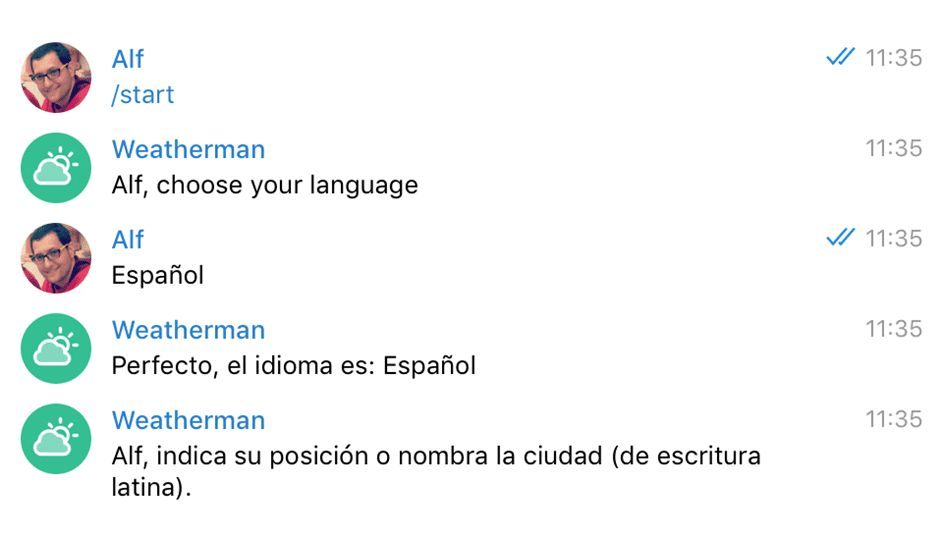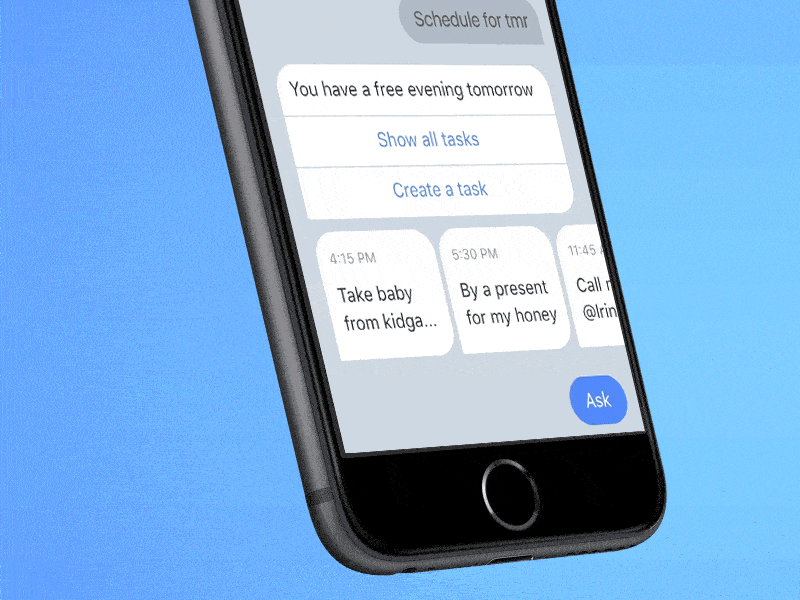
The word blockchain is everywhere on the web, but there’s another word that’s not receiving half the attention and is steadily moving towards changing -thanks to its technology- the way we relate to machines and, by extension, to databases. That word is BOT, short for robot or chatbot.
Would you like to see a practical example?
We will start specifically with a chatbot, i.e. an assistant bot with which we interact via online messages, commands and requests (voice commands are another alternative). As an example we will use Telegram, an instant messaging application similar to Whatsapp, though less popular but safer and with better quoting options, possibility to exchange files of any format up to 1,5GB, etc. If you want to check what we’ll be doing next, you can download the app here for Android and here for iOS – you won’t regret it!
Let’s try for example @weatherman_bot, a utilities bot that gets us the weather forecast anywhere in the world.
We search this bot in Telegram and once inside we’ll be asked to choose a language and share our location.

It will give us the weather forecast anywhere in the world straight away, which we can very easily view by days or hours.

Thanks to two simple app-like buttons we can choose to either get a summary or an hour-by-hour forecast.
Informational bots
Automatic customer support agents that answer questions.
Application / transactional bots
For example, to create agents to process orders.
Business productivity bots
To customize connections through business data resources.
Device control bots
To send control commands to connected devices.
What's behind a bot?
As with apps, endless hours of programming and code lines writing to help users fulfill a need lie behind a bot.
Bots are nothing new. Internet search engines (i.e., Google) use them to automatically sweep the web and keep their databases updated in order to provide us with updated search results when performing a query. Bots are also behind businesses that run through the web looking for personal data for promotional purposes, for example. In social networks, bots can artificially inflate numbers of visits or followers by simulating human interaction, position hashtags and make them into trending topics.
These cases are relatively straightforward, though. The bots that will change the way we interact are those designed to assist us in decision making, which require a more complex programming.
How will bots change our relationship with business?
In this context, Sergio Aguado, CTO and co-founder of Cuatroochenta, explained that apps will undergo an interface change in order to become more conversational: “Social networks and chats will be the connection for such change.”
Whatsapp is already taking the first steps in this direction with its product Whatsapp Bussines, which aims to be the communication channel for businesses and individuals, by providing businesses, as they themselves say, with a verified profile so that people can distinguish businesses from other persons, and with an easier way to reply to messages, which may even provide additional information. One or more bots will be in the background, allowing customers and users to feel they are interacting with someone on the other side through writing and, specially, voice.

Large companies already know that this is the field where the next game will be played. For example, Amazon is offering Lex: “a service to create conversational interfaces with voice and text in any application”. Amazon has basically used its experience with Alexa (its virtual assistant) to offer a service that allows creating bots without having to invest in artificial intelligence, hardware scalability, etc.
The thing is that there is a huge amount of applications out there to create conversations, such as Collect.chat, Flow XO, Chatfuel, and many more, which proves the importance already gained by this “new channel”.
It should be clarified that programs like Alexa, Google Now, SIRI, Cortana, Facebook’s M (on the verge of retirement) or VIV aren’t bots, but virtual assistants. While assistants are generalists, bots are specialists, i.e., they are designed to perform very specific tasks. Assistants use bots to perform more specific tasks.
By using bots, businesses will aim at “improving user experience, allowing customers to interact in multiple ways, through different channels, by reinforcing physical channels and improving the telephone channel”. A practical application of the new role of bots in the way people and businesses/organizations relate to each other could be the application developed by Cuatroochenta for the Municipal Transport Company (Empresa Municipal de Transportes or EMT) in Valencia, widely welcomed, and which will be the subject of a separate article, because it is very interesting.
Human resources or communication departments
Other areas where chatbots can be used are both recruitment and briefing/coaching of new staff. In the first days after recruitment, when a newcomer is lost and does not dare to ask, for instance, about holidays, having an (anonymous) and efficient system such as a chatbot to respond to these issues will not only help the newcomer integrate but also increase his/her performance as a result of an improved confidence and perception of the company.
Likewise, businesses can also use that feedback to improve processes, change strategies, etc., by analyzing the information provided by the application.
Healthcare
As shown in this article by Víctor Osorio, using chatbots can improve adherence to treatments. “Experience shows that isolated digital solutions have low impact or little success, so it is important that these chatbot-based services can become part of an integrated healthcare model which facilitates or supports healthcare continuity when patients are not in consultation, by adapting the information to the needs of the different patients’ profiles”.